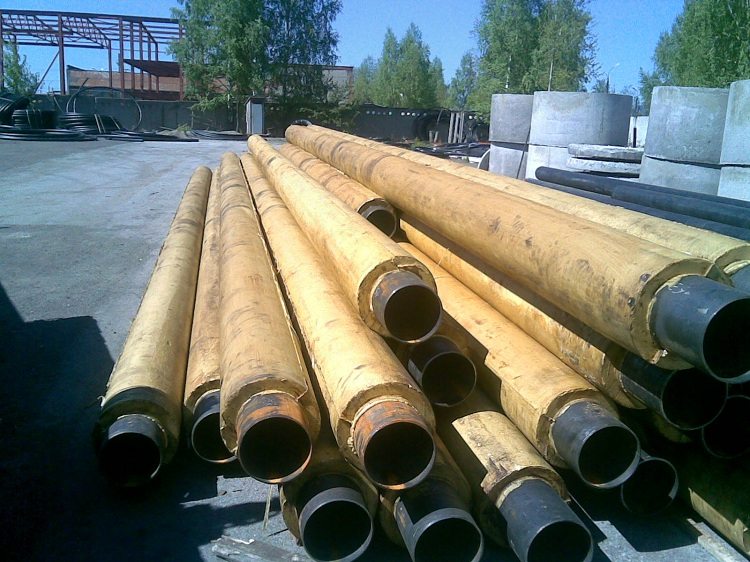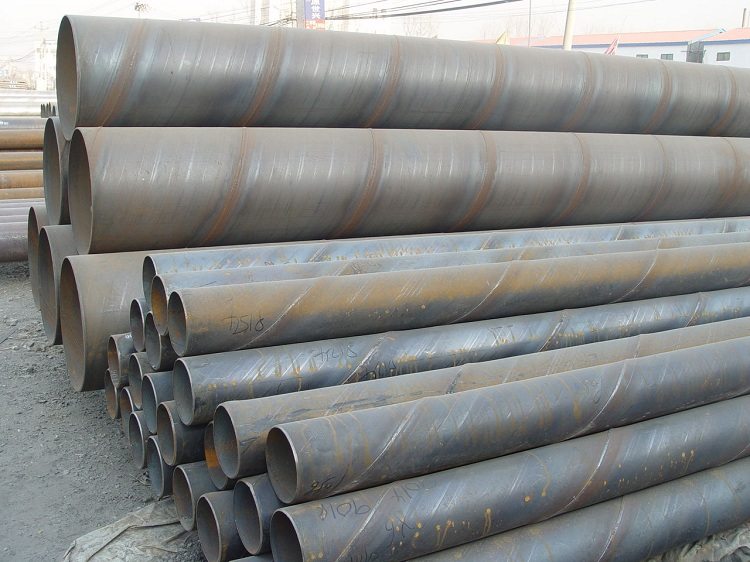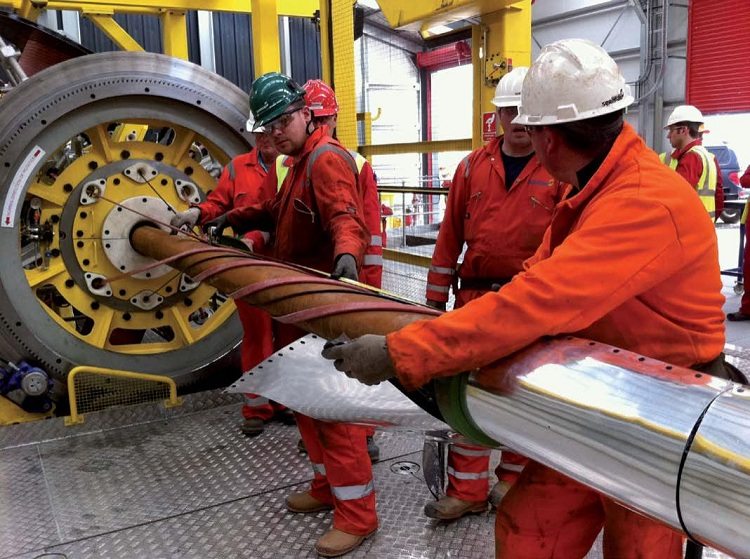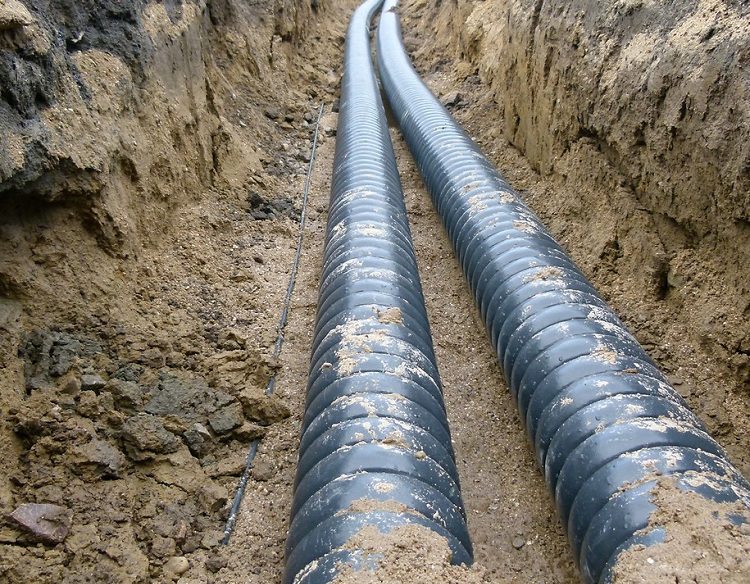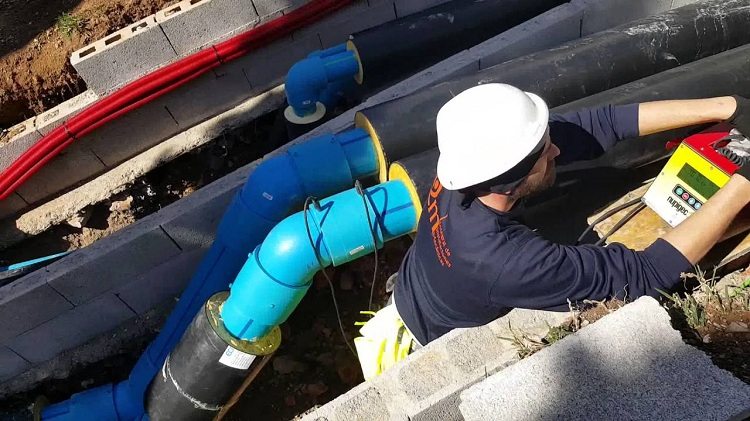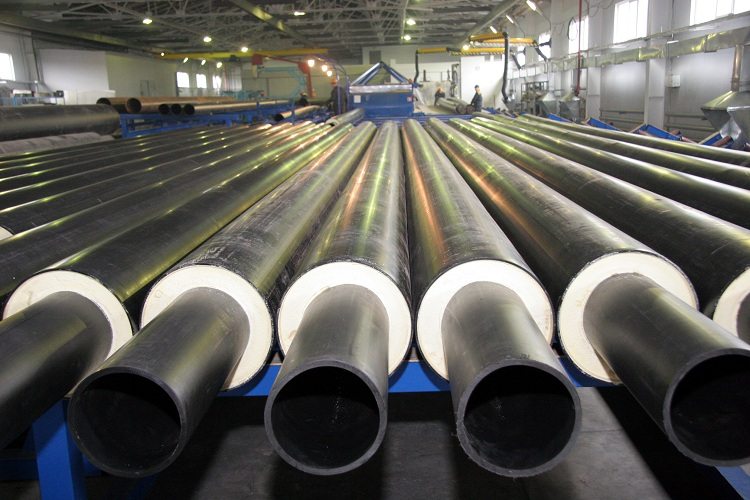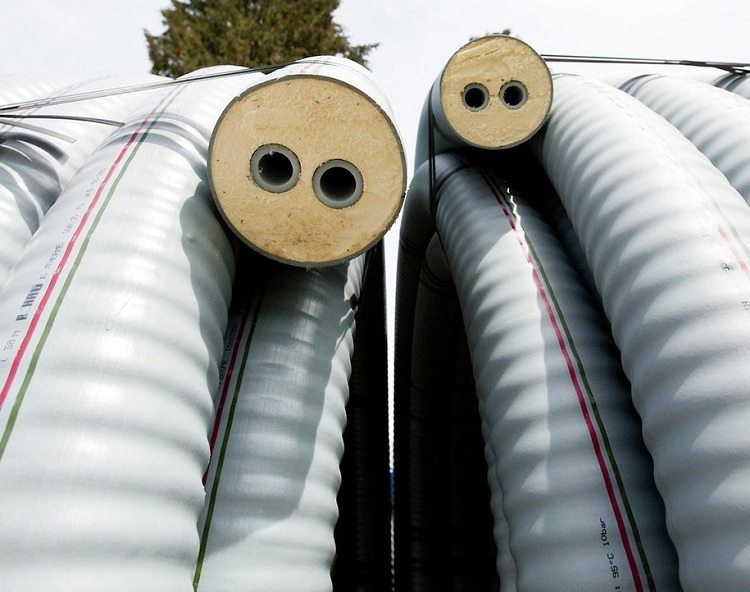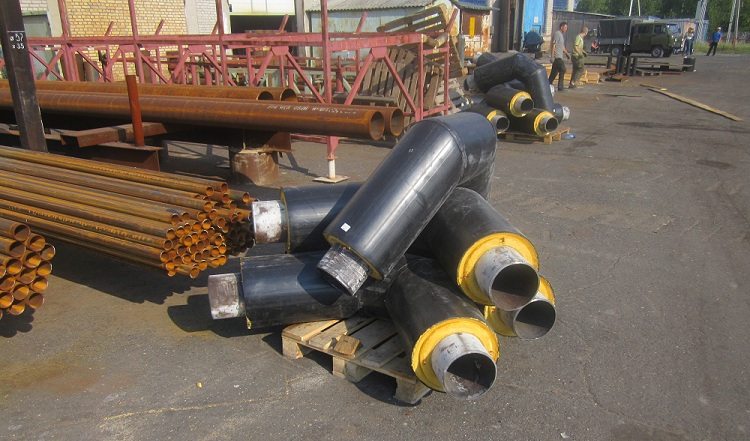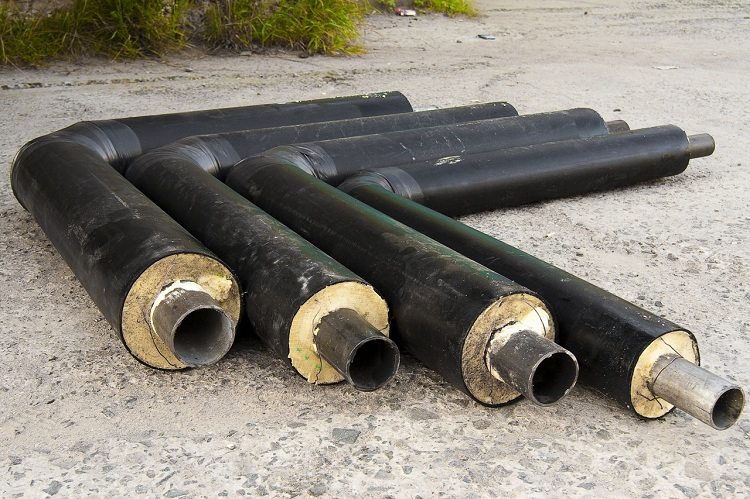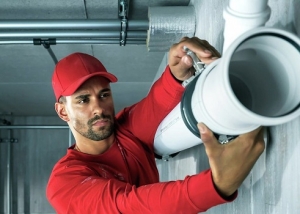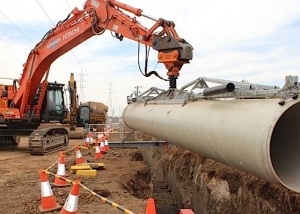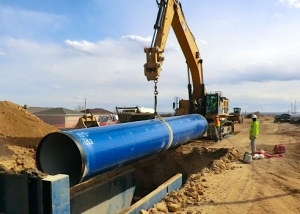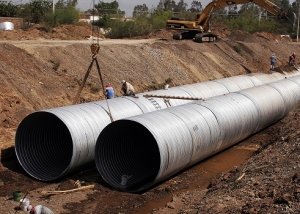Heat losses are an extensive problem familiar to everyone, which is accompanied by a waste of energy resources, heat, money. Such losses are enough to reflect and take effective measures to prevent them. To date, many technologies for heat conservation using heat-insulating materials have been developed and successfully applied.
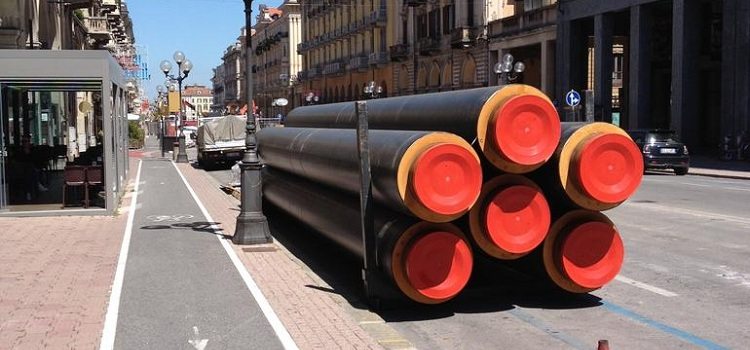
Pipes in polyurethane foam insulation - a modern material for the construction of heating mains, water supply systems and other highways
Content
- 1 What is polyurethane foam insulation?
- 2 Pipe production in polyurethane foam insulation
- 3 PPU and PPM isolation
- 4 Range of pipes in polyurethane foam insulation
- 5 Pipe in PU foam insulation with heating cable
- 6 Pipe in polyurethane foam insulation reinforced with bandage
- 7 Plastic pipes in polyurethane foam
- 8 Plastic flexible pipes PPU
- 9 Pipes and fittings in polyurethane foam insulation
What is polyurethane foam insulation?
Polyurethane foam pipe insulation (PUF) is a two-layer coating consisting of a foam-like plastic heat insulator - polyurethane foam (its elastic modification is called foam rubber), covering the pipe and the outer shell of high density polyethylene (HDPE) as a protection. There are options in three layers, two cortical from polyethylene and between them polyurethane foam. The coating has no longitudinal seams and joints. The effectiveness of such insulation is recognized worldwide and is considered one of the best ways to avoid heat loss of the pipeline. Its main tasks: maintaining the integrity of the pipe (protection against corrosion, damage) and reducing the thermal conductivity. The thermal conductivity coefficient of insulation varies between 0.025 - 0.032 W / (m · K) (mineral wool - 0.070 W / (m · K), glass wool - 0.050 W / (m · K)).
The main component of the insulation coating is polyurethane foam. This is a plastic obtained from petrochemical industry products 80-95% consisting of gas filling the fine-meshed structure. The rest of the plastic volume is occupied by the walls of cells isolated from each other, which make up the rigid frame of the foam. It is this composition of polyurethane foam that is widely applicable in construction works due to its properties:
- lack of thermal conductivity;
- high adhesion to various types of surfaces;
- very light, strengthens the pipe without weighing it down;
- operating temperature from -180aboutC to 200aboutC, the metal pipe in the PU foam insulation can be operated in conditions of -85aboutC to 140aboutWITH;
- coolant temperature 130aboutC - 150aboutWITH;
- integrity of the coating without joints and seams during spraying;
- excellent insulating qualities, waterproof, moisture absorption of 1% per day from the initial volume;
- resistance to aggressive environment of acids, alcohols, oil products, chemical vapors and esters;
- soundproofing;
- lack of caking, corrosion, rotting, infection with a fungus. PPU insulation tens of times reduces the process of corrosion of a metal system;
- low combustibility due to phosphorus-containing and halogen fillers, has three groups: C - self-extinguishing, TV - flame retardant, TS - flame retardant;
- environmentally friendly, safe after hardening, since during spraying a large number of particles are concentrated in air. Carbon monoxide begins when heated to 600aboutWITH;
- service life of 30+ years.
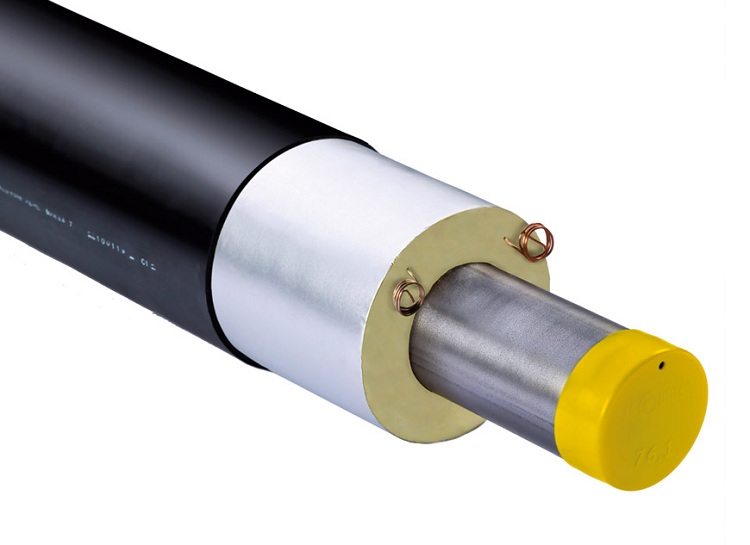
Polyurethane foam insulating layer is located in the middle between the working pipe and the outer protective coating.
Pipe production in polyurethane foam insulation
Thanks to the installation of a filling line for the production of PPU shells, enterprises specializing in the production of pipes provide a full cycle of products, reducing their cost. Production is accompanied by strict compliance with GOST, control of all stages of production. The filling process itself is fast and economical, the pipe in isolation is obtained by a molded, one-piece construction. The polyurethane foam layer does not involve the use of a large amount of the starting material. To do this, proportionally balanced liquid components (polyol and polyisociant) are supplied under pressure into the void between the tube and the outer cortical PND membrane. There, the components harden, forming an insulation layer. In this case, full contact of the contacting materials occurs.
Before that, the surface of the steel pipe is shot-blasted, then it is outwardly equipped with several centering support rings made of polyethylene and a cable for remote tightness control (ODK) along the entire length, special plugs are installed on the pipe ends. One PUF shell can accommodate from 1 to 6 pipes (multi-pipe engineering systems).
The protective HDPE coating is adapted for laying the pipeline in soil to a depth of 2 m to 8 m. The external (air) line is covered with a layer of galvanized steel. According to the thickness of the insulation foam, they are of two types: type 1 - standard (moderate latitudes) and type 2 - reinforced (latitudes with a frosty climate).
PPU and PPM isolation
On the basis of rigid polyurethane foam, foam-polymer-mineral thermal insulation (PPM) is also made by slightly changing the composition by adding finely divided mineral fillers (sand, ash). The result is a durable coating with the properties of polymer concrete and polyurethane foam, which significantly reduced the consumption of incoming components and cost while increasing the mechanical, thermal characteristics.
PPM insulation is also made in three layers, however, all layers are made of a homogeneous composition of different densities. The first outer layer is high-strength 10-15 mm with a density of 400-600 kg / m3 allows you to maintain the integrity of the entire insulation, resistant to mechanical damage, stress and waterproof. The second more porous layer can be of different thickness, depending on heat loss, with a density of 80-200 kg / m3. Third 5-10 mm, density 300-400 kg / m3 adjacent to the pipe, reliably protecting it from corrosion.
Insulated pipes PPU PPM when used as heating networks showed the comparative characteristics presented in the table.
Table 1
| Index | PPU | MRP |
| Thermal conductivity, W / (m · K) | 0,025 – 0,032 | 0,041 – 0,044 |
| Coolant temperature aboutWITH | 150 | 150 |
| Bulk weight (density), kg / m3 | 60 | 350 |
| Compressive strength, MPa | 0,15 – 1 | 1,5 |
| Bending Strength, MPa | 0,35 – 1,5 | 0,5 |
| Water absorption,% | 1 | 0,5 |
| Adhesion, MPa | 0,12 | 0,49 |
| Damage depth when striking with energy of 14 J on the outer layer (dent, scratch), mm | 2 - 2.5 polyethylene | 2,5 – 2,8 |
| Service life, years | >30 | >30 |
Pipes in polyurethane foam insulation have less thermal conductivity, and to reduce this indicator in products with PPM, the thickness of the middle layer increases by 15-25%. The water absorption of both coatings is negligible, so the steel pipe is completely protected from oxidation. This is evidenced by studies of samples of heating networks operated under normal conditions over a 20-year period. After removing the insulation, the outer surface of the steel pipeline retained its integrity.
There is a problem of moistening the docking zone at the boundaries of the isolation PPM; when pouring the joints, it is not possible to achieve absolute monolithicity, and this leads to the leakage of water to the metal pipe. Such a factor can be eliminated by the vapor permeability of PPM (the ability to dry after wetting), but only during the period of movement of the coolant under the condition of channel laying.When laying in soil whose moisture is variable, there will be no drying without additional heating.
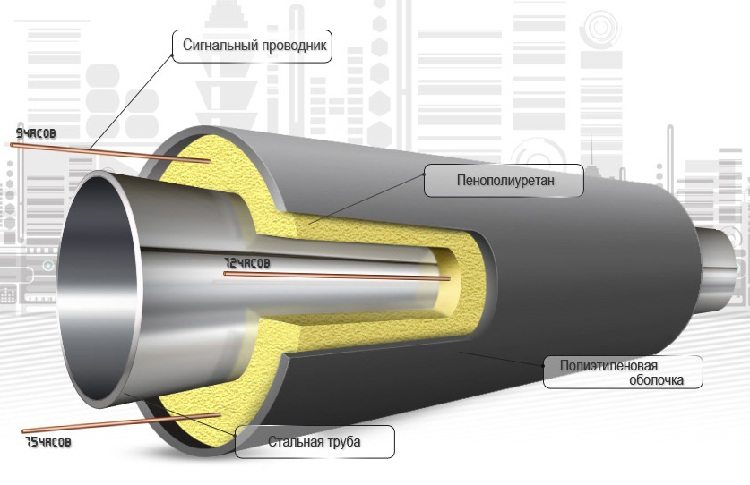
Pipes in polyurethane foam insulation are equipped with a system of ODK, which allows you to control the humidity of the insulating layer
The presence of leaks in the pipeline due to wall defects, the pipe seam greatly reduces the heat-insulating properties of the PPM, while the leak-tightness monitoring system installed in the polyurethane foam sheath (the electrical conductivity changes due to exceeding the insulation moisture level) makes it possible to detect the slightest leak and repair, thereby preventing further emergencies.
Important! The porous structure of PPM (25% of the entire surface of the coating) under conditions of wet, salt-containing soil reduces the corrosion rate of a steel pipe by four, while the anticorrosion properties in tap water are 100 times higher. At 45aboutWith salt fluid from the soil reaches the steel surface in a period not exceeding one day.
In comparison with PPU, PPM insulation possesses such qualities as ease of repair and installation work. The damaged section of the pipe is repaired without the use of fittings, the joints are filled with insulating components that can be prepared directly at the repair site. All work is carried out without removing the entire pipe, which significantly reduces costs.
The main advantage of PPM is its strength. The cortical layer does not contain voids and shells, can withstand loads, damage, significantly increasing the durability of the pipeline. For aerial styling, UV protection is required by applying light reflective paint.
Range of pipes in polyurethane foam insulation
The isolated parts of the PPU trunk and fittings made the process of building heating networks more practical, significantly reducing the time and budget for installation. The pipeline itself, passing the coolant, can be made of various materials using various production technologies. The variety includes steel electric-welded or seamless pipes, as well as plastic HDPE rigid or flexible products with a wide selection of sizes.
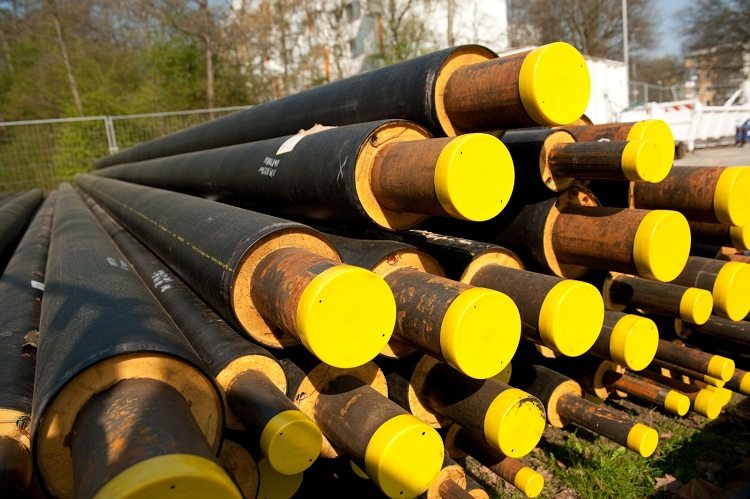
Pipes insulated with polyurethane foam are available in different diameters and with different wall thicknesses.
Steel pipes for heating networks are the most tested and common material. Insulated pipelines for special underground pipelines are manufactured in a special design consisting of:
- steel pipe, black or galvanized;
- centering support rings;
- a layer of insulating polyurethane foam, with an ODK copper cable laid in it;
- protective PND shell;
- special channel with heating cable (equipped if necessary).
With an increase in the diameter of the working pipe, the number of indicator wires can increase from 1 to 3. For above-ground networks, the same design is covered with galvanized steel instead of polyethylene, and the UEC cable can be excluded due to open access for inspection and repair work. The pipeline is reliable, highly durable, withstands fluid temperatures of 150aboutC at a pressure of 1.65 MPa, under normal conditions, with proper control, it has been in operation for 30 years.
The length of the steel component is usually 8-12 m (outer Ø 32-219 mm), 10-12 m (outer Ø 219-1420 mm). The length of the exposed ends of the pipe is 150 mm (outer Ø 32-315 mm), 250 mm (outer Ø 400-1420 mm).
The sizes of steel pipes (seamless, electrowelded), insulated polyurethane foam in a polyethylene sheath (PE), are presented in taitsa No. 2.
table 2
| Outer Ø of steel pipe, mm | Wall thickness of steel pipe, mm | Pipe standard PPU (type 1) | The pipe strengthened PPU (type 2) | ||
| PE shell Ø / wall thickness, mm | PPU thickness, mm | PE shell Ø / wall thickness, mm | PPU thickness, mm | ||
| 32,0 | 2,8 | 90;110;125/3,0 | 27,0;36,0;43,6 | — | — |
| 38,0 | 3,0 | 110;125/2,5 | 33,1;40,6 | 125/3,0 | 43,6 |
| 45,0 | 3,0 | 125/2,5 | 37,5 | 125/3,0 | 37,0 |
| 57,0 | 3,5 | 125/3,0 | 31,0 | 140/3,0 | 38,0 |
| 76,0 | 3,5 | 140/3,0 | 29,0 | 160/3,0 | 39,0 |
| 89,0 | 3,9 | 160/3,0 | 32,5 | 180/3,0 | 42,5 |
| 108,0 | 4,0 | 180/3,2 | 32,8 | 200/3,2 | 42,8 |
| 133,0 | 4,5 | 225/3,5 | 42,5 | 250/4,0 | 54,5 |
| 159,0 | 4,5 | 250/4,0 | 41,5 | 280/5,6 | 55,0 |
| 219,0 | 6,0 | 315/5,0 | 43 | 355/5,6 | 61,9 |
| 273,0 | 6,9 | 400/5,6 | 57,9 | 450/5,6 | 83,0 |
| 325,0 | 7,0 | 450/5,6 | 56,9 | 500/6,2 | 81,3 |
| 426,0 | 7,0 | 560/7,0 | 65,0 | 630/8,0 | 94,0 |
| 530,0 | 7,0 | 710/8,0 | 82,0 | — | — |
| 630,0 | 7,9 | 800/9,0 | 76,0 | — | — |
| 720,0 | 8,0 | 900/9,9 | 80,1 | — | — |
| 820,0 | 8,0 | 1000/11,2 | 78,8 | 1100/13,9 | 126,1 |
| 920,0 | 10,1 | 1100/12,5 | 77,5 | 1200/15,0 | 125,0 |
| 1020,0 | 11,0 | 1200/13,9 | 76,1 | — | — |
| 1220,0 | 11,0 | 1425/14,6 | 87,9 | — | — |
| 1420,0 | 12,0 | 1600/15,0 | 75,0 | — | — |
The sizes of steel pipes (seamless, electrowelded), insulated polyurethane foam in a galvanized shell (OC) are shown in table No. 3.
Table 3
| Outer Ø of steel pipe, mm | Wall thickness of steel pipe, mm | Pipe standard PPU (type 1) | The pipe strengthened PPU (type 2) | ||
| OTs shell Ø / wall thickness, mm | PPU thickness, mm | OTs shell Ø / wall thickness, mm | PPU thickness, mm | ||
| 32,0 | 2,8 | 90;110;125/0,5 | 28,5;38,5;46 | — | — |
| 38,0 | 3,0 | 110;125/0,5 | 35,5;43,0 | — | — |
| 45,0 | 3,0 | 110;125/0,5 | 32,0;39,5 | — | — |
| 57,0 | 3,5 | 125/0,5 | 33,5 | 140/0,5 | 41,0 |
| 76,0 | 3,5 | 140/0,5 | 31,5 | 160/0,5 | 41,5 |
| 89,0 | 3,9 | 160/0,5 | 35,0 | 180/0,5 | 45,0 |
| 108,0 | 4,0 | 180/0,5 | 35,5 | 200/0,5 | 45,5 |
| 133,0 | 4,5 | 225/0,5 | 45,5 | 250/0,5 | 58,0 |
| 159,0 | 4,5 | 250/0,5 | 45,0 | 280/0,5 | 60,0 |
| 219,0 | 5,9 | 315/0,5 | 47,5 | 355/0,5 | 67,5 |
| 273,0 | 6,9 | 400/0,5 | 63,0 | 450/0,5 | 88,0 |
| 325,0 | 7,0 | 450/0,5 | 62,0 | 500/0,5 | 87,0 |
| 426,0 | 7,0 | 560/0,7 | 66,3 | 630/0,7 | 101,3 |
| 530,0 | 7,0 | 710/0,7 | 89,3 | — | — |
| 630,0 | 7,9 | 800/0,7 | 84,3 | — | — |
| 720,0 | 8,0 | 900/0,8 | 89,2 | — | — |
| 820,0 | 9,0 | 1000/0,8 | 89,2 | 1100/1,0 | 139,0 |
| 920,0 | 9,9 | 1100/1,0 | 89,0 | 1200/1,0 | 139,0 |
| 1020,0 | 10,9 | 1200/1,0 | 89,0 | — | — |
| 1220,0 | 11,0 | 1425/1,0 | 101,5 | — | — |
| 1420,0 | 12,0 | 1600/1,0 | 89,0 | — | — |
The PPU layer can be made of various thicknesses according to customer requirements, based on the calculation of heat loss under certain conditions of laying the pipeline. According to GOST, not only seamless, but also electric-welded pipes in polyurethane foam insulation are applicable for transporting water, gas, and oil products: electric-welded straight-line-seam and electric-welded spiral-welded.
Not so long ago, a steel flexible pipe in PPU insulation began to be used. It is used for channel-free soil laying as heating networks, cold and hot water pipes. It is especially convenient to use such instances in impassable canals, densely built-up areas where obstacles are required to be enveloped, and the length (from 55 m to 720 m depending on the diameter) requires installation with a minimum number of joints without the use of welding, stationary supports and thermal compensation devices displacements. The time and labor costs of land and installation work are reduced by 5 times. The laying method is applied by horizontal directional drilling, which allows you to save the roadway. The connection is made using fittings.
Despite its flexibility, steel flexible pipelines in polyurethane foam have proven themselves to be reliable, durable material with stable characteristics, absolutely not subject to corrosion.
The structure of this design includes: pressure corrugated flexible pipe made of stainless steel, a layer of polyurethane foam, cortical corrugated polyethylene sheath. Perhaps the addition of heating cable and the UEC system. The diameter of the pressure pipe is from 54 mm to 163 mm, the wall thickness is from 0.5 mm to 1 mm. Diameter with thermal insulation from 115 mm to 226 mm. The bending radius is from 1 m to 2, 2 m. A flexible pipe works in polyurethane foam with liquid media with a temperature of 120aboutC - 150aboutC and a pressure of 1.6 MPa.
Pipe in PU foam insulation with heating cable
There is another factor that occurs in the winter period, which is taken into account in the manufacture of PPU pipes. Liquid substances passing through pipes change their properties with decreasing temperature, for example, water freezes at a zero point of a thermometer, and oil products acquire viscosity. To ensure their normal cross should maintain a certain temperature. This prevents breakdown of the pumping equipment and rupture of the pipe by ice jams. There is also a need before starting the fluid to heat the walls of the working pipeline so that they do not cool the contents.
All these tasks are solved by equipping the design of the insulated pipeline with a heating cable, the work of which is surface heating (skin effect). High-frequency alternating current passes along the cross-sectional surface of the heater (steel pipe-channel Ø 50 mm, wall thickness 2 mm with an insulated copper cable inside), causing its intense heat generation. At the end of the product, the cable connects to the steel channel. Conducting alternating current, heating is carried out only in the inner (1 mm) layer of the steel channel, without heating the cable. The channel surface on the outside has zero potential and is completely safe. It is attached to the surface of the main pipe. The number of conductors depends on the area of heating. Performance indicators of the installation with heating cable:
- power supply 220-6000 V 50Hz;
- power per meter of trunk 5-120 W;
- voltage up to 5000 V;
- constant working temperature 56aboutC short-term 85aboutWITH;
- cross section 32-50 mm2.
The installation of a thermostat will reduce the power consumption of the heating system and make it more economical.Based on the indicators of the temperature sensor installed on the surface of the pipe in the most cooled section, the thermostat will maintain the required temperature. The insulated pipeline with a heating cable can be laid locally, thereby heating certain sections of the networks, underground, aboveground methods, as well as under water.
Pipe in polyurethane foam insulation reinforced with bandage
For laying the insulated pipeline under the ground in a channel-free manner in places where additional measures are required to ensure the protection, stability, tightness and safety of the working pipe (automobile and railway crossings), special cases and bandages are used that are attached externally along the entire length of the PUF shell. The bandage is a plastic PE ring-shell 5-43 mm thick, increasing the strength of the insulation structure, while providing easy access during repair work.
The insulation reinforced with PPU bandage is provided:
- protection against loads and damage to the external HDPE shell;
- reduced mobility in the ground;
- resistance to abrasion, wear.
Plastic pipes in polyurethane foam
The use of plastic materials for the construction of heating networks and insulated pipelines for other purposes in our open spaces began relatively recently. Their wide distribution and many years of experience in European countries have generated trust. Insulated polymeric foam pipes are adapted for the installation of hot and cold water supply, sewage, heating, fire extinguishing, process, gas and oil pipelines in harsh climates and flooding of territories with laying above the level of soil freezing, which significantly reduces the time and cost of building communications.
The design of a thermally insulated plastic product includes:
- the main pipe is made of polyethylene (HDPE, PVD, PE-X - cross-linked PE), it can also be made of polyvinyl chloride (PVC), polypropylene (PP), multilayer polymer combinations;
- polyurethane foam coating with a thickness corresponding to the usual 1 or reinforced type 2;
- protective cover made of galvanized steel or plastic. PPU shell can be without a protective layer, since the design has anti-corrosion properties. To strengthen the structure, the cortical layer is often corrugated, increasing ring stiffness.
Characteristics of the PND pipe in PPU insulation:
- effective thermal insulation, due to minimal thermal conductivity;
- operating temperature from -140aboutC to 150aboutC. Polyurethane foam insulation eliminates the temperature limits of polyethylene in the environment;
- fluid temperature 90aboutC, short term 100aboutWITH;
- working pressure 1.6 MPa;
- no fluidity at elevated temperatures;
- complete absence of corrosion, oxidation, rot;
- resistance to chemicals;
- no hydraulic resistance and clogging due to the smooth inner surface of the plastic pipe;
- high structural strength at sub-zero temperatures (does not deteriorate when water freezes);
- resistance to loads, wear, water hammer;
- a light weight;
- service life of 50 years.
The thermal conductivity of polyethylene is 0.36 W / (m · K), steel 58 W / (m · K). PE pipe essentially without heat insulation has heat-saving properties.
Plastic pipelines can also be equipped with a self-adjusting heating cable. A channel is attached to the working PND pipe, where a thermal cable is laid, connected to the power supply through the switch. The polymer components of the cable create the effect of a parallel decrease in resistance and temperature, while the current movement increases (one and a half times higher than the nominal value) and, accordingly, heat production.With increasing temperature, the opposite effect is obtained, then the process is stabilized and the pipeline is heated with constant heat generated by the heating cable. This system does not overheat and does not burn out. The cable length should not exceed 75 m from one power source.
Important! The period of time from the moment of stopping the liquid substances inside the polymer pipeline in the polyurethane foam insulation located in the freezing soil to the moment of ice formation takes several days.
PPU polymeric pipes are seamless, their design is monolithic, installation is reliable, installation, cutting is simple and convenient. There is a limitation in temperature and diameter (the diameter of the thermal carrier pipe over 160 mm must be steel).
The range of insulated plastic tubular products is expanding rapidly. Among the most popular materials, one or multi-tube polyurethane foam insulated polyethylene pipelines are flexible and rigid. The length is 5-6 m, flexible pipes are delivered in bays from 10 m to 400 m long.
The sizes of HDPE (low pressure polyethylene) pipes insulated with PUF in a galvanized shell (OC) are shown in table No. 4.
Table 4
| External Ø PND pipes, mm | PND wall thickness, mm | PPU thickness, mm | The thickness of the protective OTs shell, mm | ||
| type 1 | type 2 | type 1 | type 2 | type 1, type 2 | |
| 32 | 1,9 | 3,0 | 47,0 | 58,0 | 0,5 |
| 40 | 2,3 | 3,7 | 43,0 | 56,0 | 0,5 |
| 50 | 2,9 | 4,6 | 40,0 | 52,5 | 0,5 |
| 63 | 3,7 | 5,9 | 41,0 | 54,0 | 0,5 |
| 75 | 4,3 | 6,8 | 41,5 | 55,0 | 0,5 |
| 90 | 5,0 | 8,3 | 45,0 | 60,0 | 0,5 |
| 110 | 6,4 | 10,1 | 45,5 | 60,0 | 0,6 |
| 125 | 7,2 | 11,4 | 45,5 | 60,0 | 0,6 |
| 140 | 7,9 | 12,8 | 45,5 | 60,0 | 0,6 |
| 160 | 9,0 | 14,7 | 45,0 | 62,0 | 0,6 |
| 200 | 11,4 | 18,3 | 45,5 | 62,0 | 0,7 |
| 225 | 12,8 | 20,6 | 47,5 | 67,5 | 0,7 |
| 250 | 14,3 | 22,6 | 50,0 | 82,0 | 0,8 |
| 280 | 16,0 | 25,5 | 62,5 | 87,0 | 0,8 |
| 315 | 18,0 | 28,6 | 62,0 | 87,0 | 0,8 |
Plastic flexible pipes PPU
The warmed plastic flexible design is completely made of polymer components, combining the best working qualities. It is used in the construction of heating networks, highways of hot, cold water, technical systems of the food and chemical industries. Flexible pipes have the characteristics of PPU plastic pipes, their feature is in simplified laying and installation due to the length (up to 400 m in the bay). The pipeline requires less connecting, turning parts, you can form a line of the highway of any complexity without compensators and supports even in seismically hazardous areas. Possible bending radius of 800-1200 mm. Laying underground in the channel and channelless.
The main pipe is made of cross-linked polyethylene, the basis of which is high density polyethylene (HDPE). Its molecular structure undergoes cross-linking from exposure to peroxides (PE-Xa) or silanides (PE-Xb) at the time of extrusion, and a three-dimensional plastic structure is formed with unique properties: high strength, heat resistance, elasticity, molecular (temperature) memory (restoration of the original state after deformation and heating). Such products in one foam insulation can be from 1 to 4. Diameter is from 16 mm to 110 mm, working pressure is 6, 10 bar.
It is also possible to cover with layers of reinforcing fiber and a polymer shell to protect the system from oxygen. The anti-oxygen barrier (hydroxide-ethyl vinyl layer) prevents the penetration of oxygen vapor through the walls of the plastic into the heating system, reducing corrosion and prolonging the life of the pipes.
Due to the combination of components, the polyurethane foam shell acquires elastic properties, reducing the rigidity index. Semi-rigid polyurethane foam insulation gives flexibility to pipes without losing their heat saving. Reliable adhesion to the surface of PE does not allow delamination during thermal elongation. Winding tubular products with a coil or a drum does not violate their solidity and integrity. The thickness of the PPU layer can be determined by the customer based on the project or the conditions of the laying environment (normal, reinforced). The outer waterproof polyethylene layer is available in the form of a corrugation. The flexible design is complemented by a heating cable. The diameter of the pipe in the shell is from 90 mm to 160 mm.
Pipes and fittings in polyurethane foam insulation
PPU shaped products - insulated construction of auxiliary elements used during installation of the pipeline to perform connections, turns, branches and other tasks. They are produced at enterprises manufacturing thermally insulated pipes, their structures coincide in diameter, wall thickness of the supporting pipe, and the composition of the shell (ordinary, reinforced). The main thing in assembling a heat-saving main is the installation of docking assemblies, which must be reliable, airtight, without heat loss and the risk of pipeline corrosion.
The shaped parts consist of a segment of the working pipe (steel, plastic), which is formed according to the purpose, centering supports, a layer of warming polyurethane foam, a protective sheath made of polyethylene (laying in the ground) or galvanized steel (overhead laying). The steel shell involves the laying of an electrical insulating tube in the foam layer. The composition is often supplemented by an operational remote control system for tightness of the structure (UEC).
The modern assortment of fittings in polyurethane foam insulation is wide and improved thanks to many years of experience in applying various technologies for heat storage in engineering systems.
Shaped parts in polyurethane foam for steel pipes:
- branch - an element of bending, turning straight lines of the pipeline in various planes by 30; 45; 60 and 90 degrees. It has various sizes (steel pipe Ø 60-1020 mm), shoulder length (720-1620 mm), foam shell thickness (normal 34-90 mm; reinforced 40-140 mm). There are bends according to the type of pipe for electric-welded and seamless. Electric-welded pipes are cut into pieces, from which they form the right angle of elbow by means of a weld, seamless ones are subjected to heating and bending;
- transition - a detail of the direct connection of two pipelines of varying diameters for narrowing. In the horizontal plane, the transition is performed in compliance with the axis of symmetry (truncated cone), in the vertical, the transition is eccentric;
- tee - an element that allows you to get a branch from the main thread. The design consists of steel pipes of equal or different diameters welded to each other. For heating networks, the tee is supplemented with welded metal branch reinforcement plates that relieve the stress of the pipes and retain the structure when moving;
- parallel tee - a type of tees designed for branching the main stream or connecting two streams into one. Its difference in the location of the additional pipe to the main one is that it is parallel, made by welding the adapter with a bend;
- tee branch - a kind of tees with the same purpose and special location of the branch. It is welded perpendicularly or parallel to the main one, but with a bend that allows you to bend over adjacent communications;
- ball valve - a construction of a one-piece welded body with a spherical mechanism element located inside to block the flow of a liquid medium by rotation.
- tee with a ball valve of an air vent - tee branching, where a tap with a tap is perpendicularly welded to the main pipe, pointing upward to bleed air. Underground installation provides for the construction of a heat chamber for easy access to the crane;
- Z and U-shaped compensation details - elements that prevent temperature stress and deformation of the pipeline, its movement when changing the length. Form Z provides the transition of the system from underground to above ground. Laying provides for the presence of free space in places of bending and sliding supports;
- motionless support - a structure that divides the highway into parts for holding it against and from shear. It can be in the form of clamps or a steel shield vertically encircling the pipe.The voltage is localized in areas without mutual transfer of effort;
- the end and intermediate pipe element with an output cable is a portion of a thermally insulated pipe 1 - 2.2 m with a hole in the shell through which a cable is led that is hermetically connected to the UEC conductor in the PU foam layer in order to take readings of the moisture content of the system. They are installed in a heat chamber with constant access. The end element has a protective metal plug. If the design is supplemented by a heating cable, then it is removed from the end through the plug.
Docking of fittings with pipes in a polyurethane foam shell occurs in stages:
- a polymer shrink sleeve (OTs cover-pipe) is approaching the pipe;
- bare steel ends are welded;
- burner (85-90aboutC) the surfaces of the shells are heated from the edge of the joints;
- an adhesive sheet is glued to the heated shell;
- the coupling is shifted to the joint (OC cover overlap);
- the edges of the coupling are seated with a burner, the air tightness under pressure is checked (the edges of the cover OTs are tightened with belts, screws are screwed at a distance of ~ 90 mm at a distance of 20 mm from the edge);
- the joint cavity through the hole is poured with polyurethane foam, closed with a stopper, which is removed after the insulation hardens, the hole is welded with PE (they fix the OTs cover with self-tapping screws at the corners);
- the joint takes on a barrel shape.
In addition to casting, shell insulation of PUF joints is widely used - a hard shell in the form of a pipe cut in half along precisely matching the diameter of the steel pipe. The shell of the desired length fits the joint, wraps with an adhesive cloth, warms up with a burner (70aboutC) and fastened with a heat-shrink sleeve to protect the joints.
Important! Do not use wire to fasten the shell.
Shaped parts for plastic pipes do not have a PU foam layer, they are designed for joining bearing pipes with subsequent insulation of the connection, they are prepared before joining the pipe, cleaning off the insulation layers from its ends. There are detachable (crimp fittings) and one-piece connection (press fittings, welding).
Crimp docking (threaded) is carried out using wrenches, it must have free access without laying in the ground or monolithic laying. Such shaped parts are made of metal resistant to various liquid media, their installation is simple and quick. Among them: clamping end, branch (25, 32, 50 and 80 degrees), adapter, tee, sleeve, clamping tip, flange, nipple, coupling. If the pipe is flexible, then the docking assemblies should be fixed in order to avoid malfunctioning.
Press docking with a hydraulic or hand tool is more reliable, tight, one-piece, can be boldly insulated with polyurethane foam and seamlessly laid. A flexible design is easily formed from pipes, joints are not afraid of temperature elongation. Metal fittings are designed for use in heating and water supply systems (mounting sleeve, outlet (25, 32, 40, 50 and 63 degrees), coupler, tee, adapter).
Welding docking provides cast connection using special equipment. The fittings are made of the same polymeric material as the supporting pipe; they can be cast or welded from segments for large sizes.
Thermal insulation is carried out using an adhesive cloth, mounting foams with PPU components, heat-shrink tapes and couplings. Using the coupling, a cavity is created around the joint, two foam components contained in the foam package (they are separated by a safety clip, which is then removed) are mixed together by shaking and squeezed out into the coupling hole, foam formation reaction occurs. Then a thorough waterproofing is performed. In this way, conventional and flexible pipes are insulated.
Thermal insulation with polyurethane foam is by far the most effective and time-consuming method of heat saving and protection of any pipes proven by experience.
with
